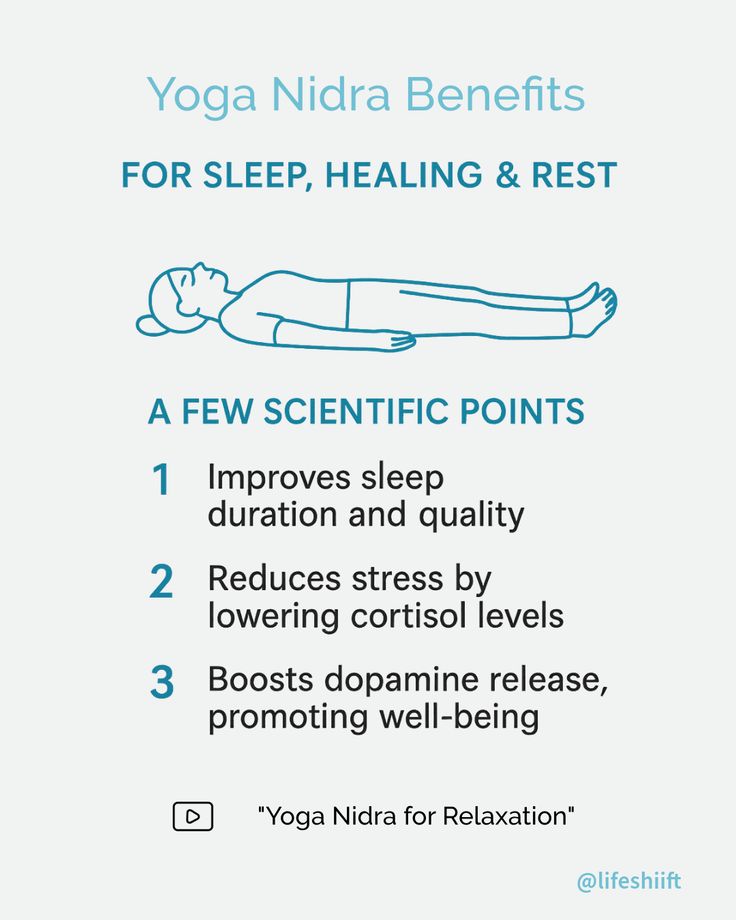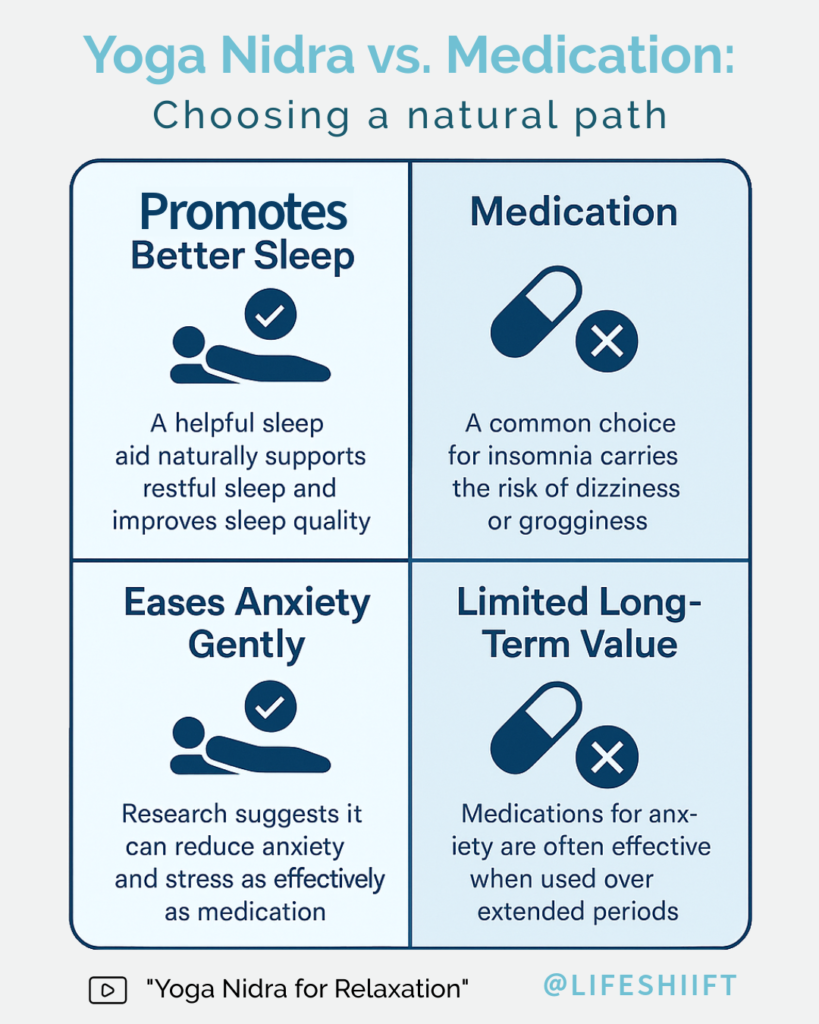Yoga Nidra for Sleep and Anxiety – A Natural Alternative to Medication
Counting sheep not cutting it? If stress or insomnia keep you up at night – especially as you navigate midlife or retirement – you’re not alone. Nearly 1 in 5 U.S. adults uses some form of medication to help them sleep, with women more likely than men to rely on sleep aids, and usage increasing with age. Yet experts caution that long-term use of sleeping pills or anti-anxiety drugs can lead to side effects and dependency.
The good news is, there’s a gentler way to unwind and rest. Introducing Yoga Nidra, often described as a “yogic sleep” meditation that works like a calm button for your body and mind. In this post – which features our guided Yoga Nidra video below – we’ll explore how Yoga Nidra can help you sleep better and ease anxiety naturally, backed by scientific research, and how it compares to medications. Grab a comfy blanket, get cozy, and let’s dive in!
What Is Yoga Nidra (Yogic Sleep)?
Yoga Nidra is an ancient relaxation technique from the yoga tradition, sometimes called “yogic sleep.” Unlike typical yoga, there are no strenuous poses – you simply lie down in a comfortable position (often on your back in shavasana pose) and listen to a guided meditation. The practice leads you into a state between awake and asleep, a kind of conscious deep rest. In fact, research shows Yoga Nidra can guide the brain into a hypnagogic state – where your brain waves slow down similar to early sleep stages – while you remain aware. This induces a profound sense of calm.
During Yoga Nidra, an instructor’s voice might lead you through steps such as relaxing different body parts, breathing exercises, and visualizations. Your nervous system gradually shifts from “fight-or-flight” mode to “rest-and-digest” mode, triggering the body’s relaxation response. Many people feel like they’re drifting in and out of sleep – and that’s perfectly OK. (Some even say that 45 minutes of Yoga Nidra feels as restorative as 3 hours of sleep!) By the end of a session, you typically experience reduced tension, a quieter mind, and sometimes the sensation of having “napped” even though you stayed conscious.
Fun fact: The term Yoga Nidra comes from Sanskrit, meaning “yoga sleep.” It was introduced to the public in the 1960s by Swami Satyananda Saraswati, who outlined the modern practice. Today, Yoga Nidra is gaining popularity as a therapeutic mindfulness practice – even Stanford neuroscientists have praised it under the label “Non-Sleep Deep Rest (NSDR).” In short, Yoga Nidra is like a guided power nap without actually falling fully asleep, leaving you deeply relaxed yet aware.
Who Can Benefit from Yoga Nidra?
One of the beautiful things about Yoga Nidra is that anyone can do it, even if you’re not flexible or have never tried meditation. It’s especially useful for people facing sleep or stress challenges. Here are some groups who may benefit from Yoga Nidra:
-
Insomniacs or Light Sleepers: If you have trouble falling or staying asleep, Yoga Nidra can calm the mind at bedtime and improve sleep quality. It’s a natural sleep aid that you can try before resorting to pills.
-
People with Anxiety or High Stress: Those struggling with anxiety, chronic stress, or PTSD often find relief in Yoga Nidra’s deep relaxation. Studies show it helps lower stress and anxiety levels by reducing cortisol and activating the relaxation response.
-
Active Agers (50+): Our Lifeshiifts community of “active agers” (adults around 55 and up) can particularly enjoy Yoga Nidra. It’s gentle on the body and addresses midlife sleep issues and stress (e.g. related to menopause or retirement transitions) without the risks of medication. As a low-impact practice, it’s perfect for seniors seeking mind-body wellness.
-
Busy Professionals & Students: Overwhelmed by work, studies, or information overload? Yoga Nidra offers a quick mental reset. Even a short session can improve focus and mental clarity by giving the brain a break, essentially acting like a conscious power nap.
-
Anyone Seeking Relaxation: Ultimately, anyone who wants to relax deeply, improve overall well-being, or practice mindfulness in an easy way can benefit. If traditional seated meditation is hard for you, Yoga Nidra is an easier alternative that guides you into a meditative state without requiring intense concentration.
If you identify with any of the above (and honestly, who doesn’t need better sleep or less stress?), Yoga Nidra is worth a try. It’s safe, accessible, and you can do it right at home.
Yoga Nidra for Better Sleep
Poor sleep is a common issue – about one-third of adults don’t get enough restful sleep, and insomnia becomes more common with age. Instead of reaching for a nighttime sedative, Yoga Nidra offers a natural path to sound sleep. Here’s how it helps:
-
Falling Asleep Faster: Research suggests that practicing Yoga Nidra may help people fall asleep more quickly and more easily. In one study, even a single Yoga Nidra session before bedtime helped participants reduce the time it took to fall asleep. The guided relaxation eases the racing thoughts and restlessness that often delay sleep onset.
-
Deeper, Higher-Quality Sleep: Yoga Nidra is known to increase slow brain waves (delta and theta waves) similar to those in deep sleep. By activating the parasympathetic nervous system (the “rest and digest” mode) and quieting the stress response, it helps increase time spent in deep, restorative sleep. People often report sleeping more soundly after regular Yoga Nidra practice. It can even feel like you’ve had hours of sleep in just a short session – for example, some practitioners say 45 minutes of Yoga Nidra feels as refreshing as 3 hours of normal sleep.
-
Non-Habit Forming Relief: Unlike a pill that forces your system to shut down, Yoga Nidra works with your body’s natural relaxation process. You might start a session awake and end up dozing off peacefully by the end. If you wake up at 2 AM, for instance, doing a short Yoga Nidra audio can often help you drift back to sleep gently, without any grogginess the next day.
Scientific interest in Yoga Nidra as an insomnia remedy is growing. A recent randomized trial found Yoga Nidra to be well-tolerated and feasible for adults with insomnia, showing improvements in breathing rate and high acceptability. Another series of studies at the National University of Natural Medicine found that Yoga Nidra led to improvements in sleep latency (time to fall asleep) after just one guided session. The participants also reported feeling mental, physical, and emotional relaxation and even brief moments of sleep or dreaming during the practice. All of this occurred while they could still recall the meditation process afterward – a unique state of rest that is both deep and conscious.
In short, Yoga Nidra helps “power down” your mind and body in preparation for sleep. It’s like gently applying the brakes on a speeding car, whereas medications are more like abruptly switching off the engine. By regularly practicing Yoga Nidra, you train your nervous system to relax on cue, making it easier over time to slip into slumber. Many people who do Yoga Nidra at night find they not only fall asleep faster but also wake up less often and feel more refreshed in the morning. If a racing mind has been your nightly nemesis, Yoga Nidra might become your favorite bedtime ritual.
Yoga Nidra for Anxiety and Stress Relief
Anxiety and sleep problems often go hand-in-hand. It’s estimated that 30–50% of adults experience insomnia or related anxiety at some point. Chronic stress and worry can keep your nervous system stuck in overdrive, leading to restless nights and frazzled days. Here’s where Yoga Nidra shines as well – in soothing anxiety and stress while it lulls you toward rest.
Multiple studies have found that practicing Yoga Nidra can significantly reduce anxiety and stress across various groups. For example, a controlled trial with 60 college professors compared Yoga Nidra to seated meditation and a no-treatment group over 3 months. The results showed that both Yoga Nidra and traditional meditation reduced anxiety and stress levels versus the control – but Yoga Nidra had a slight edge, showing greater effectiveness in easing anxiety symptoms (both the mental worry and physical tension aspects). The researchers concluded that Yoga Nidra is an effective therapeutic approach for reducing both cognitive and physiological symptoms of anxiety.
Why is Yoga Nidra so effective for anxiety? Physiologically, it helps reverse the body’s stress response. When you’re anxious, your sympathetic nervous system (“fight or flight”) is in overdrive – heart rate up, mind racing, cortisol (stress hormone) elevated. Yoga Nidra practice encourages the opposite: it slows down the sympathetic activity and boosts parasympathetic (“rest and digest”) activity, which triggers a calming effect. In essence, Yoga Nidra tells your brain and body that you are safe, allowing tension and worry to melt away. Studies using measures like heart rate variability confirm that Yoga Nidra induces this relaxation response by shifting the nervous system into balance.
Psychologically, Yoga Nidra can help break the cycle of anxious thoughts. The guided focus on body sensation and breathing anchors you in the present, interrupting mental chatter. Many people with anxiety struggle to meditate sitting upright (it can turn into a battle with their thoughts). Yoga Nidra’s lying-down, fully supported approach makes it easier to surrender control. Even if your mind wanders or you momentarily fall asleep, the practice still works on a subconscious level to relieve stress. As one researcher noted, “Yoga Nidra is a very passive and easy practice that targets physical, mental and emotional relaxation”, which is likely why it’s therapeutic for so many aspects of wellness.
Beyond general anxiety, Yoga Nidra has shown benefits in specific high-stress groups: studies have explored its use for college students, healthcare workers, people with PTSD or trauma, those with high blood pressure, and even individuals facing COVID-19-related stress. Across these diverse groups, the consistent finding is reduced anxiety, lower perceived stress, and even improvements in mood with regular Yoga Nidra sessions. Simply put, it’s a versatile stress-relief tool.
If you’re dealing with anxiety – whether it’s chronic worry, panic episodes, or just the accumulated stress of daily life – incorporating Yoga Nidra into your routine can provide a safe haven of calm. Over time, it may increase your overall resilience. Some research even suggests practicing Yoga Nidra regularly can boost your mood, confidence, and self-esteem by relieving stress. And importantly, it achieves all this without the need for medication, through deep relaxation rather than pharmacological sedation.
Yoga Nidra vs. Medication: Choosing a Natural Path
A key question you might have is: How does Yoga Nidra compare to taking medication for sleep or anxiety? The two approaches are very different. Medications (like sleeping pills or anti-anxiety drugs) act quickly to alter brain chemistry or depress the nervous system, which can be effective for short-term relief – but they often come with downsides like next-day drowsiness, tolerance or dependence, and potential interactions with other drugs. In fact, health experts generally advise against relying on sleep meds long-term due to these risks. Yoga Nidra, on the other hand, is a drug-free technique that uses the body’s own relaxation mechanisms. It may take a little practice and patience, but its benefits can be profound and lasting.
Here are some points to consider when comparing Yoga Nidra with medications:
-
Safety and Side Effects: Yoga Nidra has virtually no side effects. It’s gentle enough that even people with health issues can do it (you’re just lying down and relaxing). Unlike sleeping pills, Yoga Nidra won’t leave you groggy and doesn’t pose a risk of dependency. You can’t “overdose” on Yoga Nidra – the worst that might happen is you fall asleep! This makes it a very low-risk intervention. In fact, researchers have suggested Yoga Nidra as a low-risk complementary treatment to standard care for insomnia and anxiety, alongside approaches like cognitive behavioral therapy or prescribed meds.
-
Effectiveness: Medications can force a physiological change (e.g., knock you out or blunt anxiety symptoms) within minutes, whereas Yoga Nidra works more gradually by teaching your body to relax. That said, studies show Yoga Nidra can meaningfully improve insomnia and anxiety symptoms with regular practice. It addresses the root causes – racing mind, nervous system imbalance, stress – rather than just sedating you. Many people find that over time Yoga Nidra helps them sleep naturally without aids and feel calmer overall during the day. It’s not an instant one-pill fix, but its holistic benefits often extend beyond what medication would provide (like improved self-awareness and mood).
-
Usage and Convenience: Popping a pill might seem easier than setting aside 20 minutes for Yoga Nidra. But consider this: Yoga Nidra can be done anytime, anywhere you can lie down quietly, even in bed, and you only need a recording (or our video) to guide you. It gets more effective with repetition, whereas pills can become less effective as tolerance builds. Also, Yoga Nidra doesn’t require a prescription or doctor’s oversight to start – it’s accessible to everyone. You’re in control of your practice, and you can use it whenever you need relief (even daily) without worrying about dosage. As one wellness expert put it, “Yoga nidra is a natural sleep solution… a great alternative if you want to avoid turning to sleeping pills”.
-
Whole-Person Benefits: Medications generally target a specific issue (e.g., reduce anxiety or induce sleep) and may not improve your overall well-being. In contrast, Yoga Nidra tends to have a ripple effect on overall health – better sleep, reduced anxiety, lower stress hormones, improved mood, and even benefits like lower blood pressure and pain relief have been reported. It’s a more holistic approach. By regularly engaging in deep relaxation, you’re teaching your mind-body system how to recover and heal itself. In short: Yoga Nidra is a therapeutic tool, not just a bandaid. It can be a long-term lifestyle addition that enhances quality of life, whereas medication is often a short-term solution for acute issues.
In making a choice, you don’t necessarily have to pick one or the other. Yoga Nidra can complement medical treatments – for instance, you might use it to ease reliance on sleep medication, with your doctor’s guidance. Because it’s low-risk, many doctors and psychologists would encourage patients to try techniques like Yoga Nidra or meditation alongside conventional treatment. If you’re currently on medication for sleep or anxiety, talk with your healthcare provider about incorporating Yoga Nidra. You may find you can reduce your dose or eventually discontinue medication under professional supervision as your body learns to relax naturally. (Never stop prescribed meds abruptly without consulting your doctor.)
For those who want a natural path: Yoga Nidra offers a powerful, drug-free way to improve sleep and reduce anxiety, without the downsides of medication. It puts the power in your hands (or rather, in your breath and awareness) to activate your own healing response. Many people feel empowered knowing they have this technique to rely on whenever stress or sleeplessness strikes.
Getting Started with Yoga Nidra (Guide and Video)
Ready to experience Yoga Nidra for yourself? The best part is how simple it is to begin. To try Yoga Nidra at home, all you need is a quiet space and an audio or video guide. In fact, we’ve included a 20-minute guided Yoga Nidra meditation video from the Lifeshiifts YouTube channel right here in this post – feel free to scroll down and hit play when you’re comfortable. As you get set up, keep these tips in mind to make the most of your session:
-
Set Up a Comfortable Rest Space: Lie down on your back either on a yoga mat, a carpet, or even your bed. Use any props you need – a pillow under your knees, a small cushion for your head, or a light blanket to keep warm. The goal is to be completely at ease so you can remain still. (If lying flat is uncomfortable, you can slightly elevate your upper body with a wedge pillow.) Dim the lights and make sure the room temperature is cozy.
-
Minimize Distractions: Turn your phone ringer off, and let others in the house know you’re taking some quiet time. It’s important to create a safe, uninterrupted bubble for yourself. You might even use an eye mask or just softly close your eyes during the practice to help withdraw from external stimuli.
-
Follow the Guided Voice: Play the Yoga Nidra video below (or an audio recording of your choice) and simply listen to the instructor’s voice. Our Lifeshiifts guided session will gently lead you through relaxing your body and breathing. You don’t need to “do” anything except follow along mentally. If the voice says “focus on your right hand” or “imagine a warm light around you,” just flow with it. Let the thoughts come and go. Remember, there’s no wrong way to experience Yoga Nidra – even if you get distracted, just return your attention to the voice when you notice.
-
Release Expectations (It’s Okay to Fall Asleep!): During Yoga Nidra, you might hover between consciousness and sleep. You may even fall asleep, and that’s fine. The practice works even if your conscious mind drifts off. Don’t judge yourself if you lose track of some of the guidance – you will still gain relaxation benefits unconsciously. Over time, it might get easier to stay aware in that “twilight” state, but either way, you’re getting rest. Just let go and trust the process.
-
Finish Gently: When the session ends (or when you decide to come out of it), take your time. Deepen your breath, wiggle your fingers and toes, and roll to your side slowly. Notice how you feel – calmer, sleepier, or lighter perhaps. If it’s bedtime, you might transition right into sleep. If it’s daytime, you can gradually sit up and carry on with your day, hopefully recharged. Some people like to journal a few notes about any affirmations or feelings they experienced in Yoga Nidra, as it can bring insights or creative thoughts.
Feel free to use Yoga Nidra whenever it fits your schedule. Many enjoy it at night to improve sleep, while others take a midday Yoga Nidra break as an alternative to napping or to de-stress after work. Even just 15–20 minutes can be incredibly rejuvenating. Consistency helps – try integrating it a few times a week or daily, and see how your sleep or anxiety levels respond over a few weeks.
Most importantly, enjoy the practice! Yoga Nidra is a time for you – a chance to unplug from the bustle of life and nurture yourself with deep relaxation. No effort, no sweat, no pressure to “perform” – just rest and be.
Watch the Guided Yoga Nidra Video:
🎥 Press play, lie back, and let the soothing guidance lead you into blissful yogic sleep.
If you’re reading this and not in a position to watch the video right now, you can always bookmark this page and come back to the video when you’re ready. We’ve packed the text above with helpful info so you can benefit even without the video.
Don’t forget to subscribe:
If you found this helpful, consider subscribing to the Lifeshiifts YouTube channel for more wellness videos, guided meditations, and tips on living a vibrant, healthy life. Our community of active agers is all about supporting each other on the journey to better health and purpose – and we’d love for you to be a part of it!
Conclusion
In a world where stress and sleepless nights are all too common – and pills often seem like the only escape – Yoga Nidra offers a refreshing alternative. This age-old practice is scientifically gaining recognition as a safe, effective way to improve sleep quality and reduce anxiety. By tapping into your body’s innate relaxation response, Yoga Nidra empowers you to find calm within, whether you’re a 20-something student or a 60-year-old retiree. And it does so without the hangovers or habit-forming risks of medications.
For Lifeshiifts’ community of active agers, Yoga Nidra aligns perfectly with our mission: to live a longer, healthier life filled with vitality and calm purpose. Imagine waking up after a solid night’s sleep, feeling rested, clear-headed, and ready to pursue your passions – or approaching a typically anxious situation with a newfound sense of peace. By regularly practicing Yoga Nidra (even just a few times a week), these outcomes are within reach.
We encourage you to give it a try – what do you have to lose, except maybe some stress? 😉 Set aside a little time for yourself, follow along with our video, and let us know how you feel. Many people notice improvements in their sleep or mood after even a couple of sessions. And with continued practice, the benefits can build on each other.
In summary, Yoga Nidra is more than just a relaxation technique; it’s a lifestyle tool for better sleep, less anxiety, and overall well-being. It’s like hitting the “reset” button for your mind and body, whenever you need it. So next time you find yourself tossing and turning, or your day is overflowing with tension, remember this article and consider opting for a Yoga Nidra session. Your body and mind will thank you for it.
Sweet dreams and namaste! ✨

Sources:
-
Sharpe, E. et al., Journal of Psychosomatic Research (2023) – Yoga Nidra found to be a feasible, well-tolerated intervention for insomnia, with evidence of reduced respiratory rate and improved relaxation.
-
Ferreira-Vorkapic, C. et al., International Journal of Yoga (2018) – Yoga Nidra and meditation reduced anxiety and stress in college professors; Yoga Nidra showed slightly greater anxiety reduction, helping both cognitive and physiological symptoms of anxiety.
-
Sleep Foundation – Overview of Yoga Nidra’s benefits: helps people fall asleep faster and get higher-quality sleep; reduces anxiety and stress by shifting the nervous system into a parasympathetic state (deep relaxation response); multiple studies demonstrate anxiety/stress reduction in various populations.
-
National Univ. of Natural Medicine (Helfgott Institute) – News article summarizing Yoga Nidra research: one session improved time to fall asleep and self-reported anxiety; Yoga Nidra offers a low-risk adjunct treatment for insomnia/anxiety (to complement therapy or pharmaceuticals).
-
Washington Post (Feb 7, 2023) – Nearly 18% of Americans use medication for sleep; experts advise caution due to side effects.
-
Woman&Home Magazine – Yoga Nidra is a “natural sleep solution” and a great alternative to sleeping pills for those wanting to avoid medication; anecdotal reports that 45 minutes of Yoga Nidra can feel like 3 hours of sleep in terms of restfulness.
-
Dr. S. Rajkumar (Psychiatrist) – “Yoga Nidra is a powerful, drug-free technique to improve sleep quality, reduce stress, and enhance well-being. Unlike sleeping pills, it has no side effects and is easy to practice anytime.” (Emphasizing Yoga Nidra as a safe alternative to medication).








